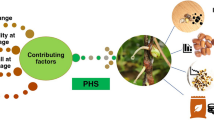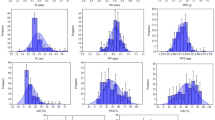Abstract
Soybean sprouts, a traditional vegetable in Asia, are gaining popularity in the United States. Soybean sprout demand has been supplied by natto (a Japanese soyfood) cultivars that share some seed characteristics with sprout cultivars. However, natto seeds do not meet all requirements of sprouts and are rejected by sprout manufacturers. The objectives of this study were to evaluate important seed and sprout traits as potential selection criteria in breeding sprout soybeans and to study the storage effect on soybean sprout quality. Almost all genotypes produced thicker and longer hypocotyls and higher fresh-sprouts than ‘MFS-561’, a commercial soybean sprout variety. Hypocotyl length ranged from 13.8 to 16.2 cm. Four fungi genera Bipolaris sp., Cercospora sp., Botrytis sp. and Caethomium sp. were isolated from seeds. Cracked cotyledons and abnormal seedlings were the two main constraints affecting soybean sprout quality. Correlation coefficients among all traits indicated that percentage and weight of high- and average-quality sprouts would determine sprout yield. Acceptable yield and several traits were recommended to be used simultaneously while breeding superior sprout soybean cultivars. Good sprout varieties should produce high-quality sprouts >48%, average-quality sprouts <38%, low-quality sprouts <14%, sprout yield >5.7 g/g seed, hypocotyl thickness >1.6 cm and hypocotyl length >13 cm. One-year seed storage at room temperature reduced sprout quality. V09-3876 and V12-1939 had superior seed and sprout traits and are promising lines for further evaluation for sprout production. Seed storage over time affects seed germination and seedling vigor, and fungi on seed can cause reduced seed quality.






Similar content being viewed by others
References
Ashworth EN, Oberdorf RL (1980) Imbibitional Chilling Injury in Soybean Axes: relationship to Stelar Lesions and Seasonal Environments. Agron J 72:923–928
Bhattacharya K, Raha S (2002) Deteriorative changes of maize, groundnut and soybean seeds by fungi in storage. Mycopathologia 155:135–141
Burton JW (1997) Soyabean (Glycine max (L.) Merr.). Field Crop Res 53:171–186
Cook DE, Rainey KM (2010) Seed coat deficiency, trait Stability, and other soybean seed quality traits for natto cultivar development. Crop Sci 50(4):1244–1249
Cui Z, James AT, Miyazaki S, Wilson RF, Carter TE (2004) Breeding specialty soybeans for traditional and new soyfoods. In: Liu K (ed) Soybeans as functional foods and ingredients. AOCS Press, Urbana, IL, pp 264–322
Elad Y, Williamson B, Tudzynski P, Delen N (2004) Botrytis spp and diseases they cause in agriculture systems-an introduction. In: Elad Y, Williamson B, Tudzynski P, Delen N (eds) Botrytis: biology, pathology and control. Kluwer Academic Publishers, Dordrecht, pp 1–6
Geater CW, Fehr WR, Wilson LA (2000) Association of soybean seed traits with physical properties of natto. Crop Sci 40:1529–1534
Ghani M, Kulkarni KP, Song JT, Shannon JG, Lee JD (2016) Soybean Sprouts: a Review of Nutrient Composition, Health Benefits and Genetic Variation. Plant Breed Biotechno 4(4):398–412
Hwang YH, Jeong YS, Lee JD (2004) Present status and future developmental direction of soy-related industries in Korea. Korea Soybean Digest 21:28–44
Kim HJ, Koo KM, Kim GN, Lee DS, Paik HD (2002) Isolation and identification of pathogenic microorganisms from soybean sprouts. Nutraceuticals & Food 7:305–309
Koizumi M, Kikuchi K, Isobe S, Ishida N, Naito S, Kano H (2008) Role of seed coat imbibing soybean seeds observed by micro-magnetic resonance imaging. Ann Bot 102(3):343–352
Koo SC, Kim SG, Bae DW, Kim HY, Kim HT, Lee YH, Kang BK, Baek SB, Baek IY, Yun HT, Choi MS (2015) Biochemical and proteomic analysis of soybean sprouts at different germination temperatures. J Korean Soc Appl Biol Chem 58:397–407
Kwon SH, Im KH, Kim JR (1972) Studies on diversity of seed weight in Korean soybean land races and wild soybean. Korean J Breed 4:70–74
Lee SH, Park KY, Lee HS, Park EH (2001) Genetic mapping of QTLs conditioning soybean yield and quality. Theor Appl Genet 103:702–709
Lee JD, Shannon JG, Jeong YS, Lee JM, Hwang YH (2007) A simple method for evaluation of sprout characters in soybean. Euphytica 153:171–180
Liu K (1997) Soybeans: chemistry, technology, and utilization. Chapman & Hall, New York
Liu KC, Pappelis J (1971) Transverse and crescent cracks in soybean cotyledons associated with imbibition. Trans Ill Acad Sci 64:43–45
Manamgoda DS, Rossman AY, Castlebury LA, Crous PW, Madrid H, Chukeatirote E, Hyde KD (2014) The genus Bipolaris. Stud Mycol 79:221–288
Mayta J, Chen P, Popp MP, Dong D, Wu CJ, Zhang B, Smith SF, Scaboo AM (2014) Break-even profitability for food-grade specialty soybeans. Agr Sci 2:01–11
Mbofung GCY, Goggi AS, Leandro LFS, Mullen RE (2013) Effects of storage temperature and relative humidity on viability and vigor of treated soybean seeds. Crop Sci 53:1086–1095
McKillup S (2012) Statistics explained: an introductory guide for life scientists. Cambridge University Press, New York
Park MH, Kim DC, Kim BS, Nahmgoong B (1995) Studies on pollution-free soybean sprout production and circulation market improvement. Korea Soybean Dig 12:51–67
Pietrzak LN, Frégeau-Reid J, Chatson B, Blackwell B (2002) Observations on water distribution in soybean seed during hydration processes using nuclear magnetic resonance imaging. Can J Plant Sci 82(3):513–519
Pollock BM (1969) Imbibition temperature sensitivity of lima bean seeds controlled y initial seed moisture. Plant Physiol 44:907–911
Prokhorov VP, Linnik MA (2011) Morphological, cultural and biodestructive peculiarities of Chaetomium species. Biologiya. 3:17–24
Sato T, Aoki M, Aoki T, Kubota M, Yaguchi T, Uzuhashi S, Tomioka K (2014) Fungi isolated bean sprouts in Japan. JARQ 48:317–329
Shi H, Nam PK, Ma Y (2010) Comprehensive profiling of isoflavones, phytosterols, tocopherols, minerals, crude protein, lipid, and sugar during soybean (Glycine max) germination. J Agric Food Chem 58:4970–4976
Silva LR, Pereira MJ, Azevedo J, Gonçalves RF, Valentão P, de Pinho PG, Andrade PB (2013) Glycine max (L.) Merr., Vigna radiata L. and Medicago sativa L. sprouts: a natural source of bioactive compounds. Food Res Int 50(1):167–175
Sorrels ME, Pappelis AJ (1976) Effect of temperature and osmotic concentration on cotyledon cracking during imbibition of soybean. Crop Soil Sci 16:413–415
Sunada K, Ito T (1982) Soybean grain quality as affected by low temperature treatments in plants (color of hilum, seed coat cracking). Rep. Hokkaido Branch Crop Sci Soc Jpn and Hokkaido Branch Jpn Soc Breed 22:34
Taira H (1990) Quality of soybeans for processed food. JARQ 24:224–230
USDA-NASS (2015) National Statistics for Soybeans United States Department of Agriculture- National Agricultural Statistics Service. http://www.nass.usda.gov/Statistics_by_Subject/result.php?D6555519-6EE0-313E-A1C7-FF36EE325E2F§or=CROPS&group=FIELD%20CROPS&comm=SOYBEANS. Accessed 3 December of 2016
Yousif AM (2014) Soybean grain storage adversely affects grain testa color, texture and cooking quality. J Food Quality 37:18–28
Zhang B, Chen P, Florez S, Shi A, Hou A, Ishibashi T (2010) Seed quality attributes of food-grade soybeans form the US. and Asia. Euphytica 173:387–396
Acknowledgement
This work was supported by Virginia Department of Agriculture Consumer and Services and Montague Farms Inc.
Author information
Authors and Affiliations
Corresponding author
Rights and permissions
About this article
Cite this article
Escamilla, D.M., Rosso, M.L., Strawn, L.K. et al. Evaluation of important seed and sprout traits as potential selection criteria in breeding varieties for sprout soybeans. Euphytica 213, 229 (2017). https://doi.org/10.1007/s10681-017-2007-0
Received:
Accepted:
Published:
DOI: https://doi.org/10.1007/s10681-017-2007-0




